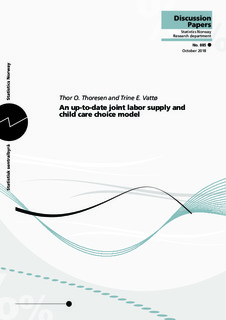| dc.contributor.author | Thoresen, Thor Olav | |
| dc.contributor.author | Vattø, Trine Engh | |
| dc.date.accessioned | 2018-11-06T10:09:47Z | |
| dc.date.available | 2018-11-06T10:09:47Z | |
| dc.date.issued | 2018-10-12 | |
| dc.identifier.issn | 1892-753X | |
| dc.identifier.uri | http://hdl.handle.net/11250/2571221 | |
| dc.description.abstract | Norwegian parents of preschool children base their care choices on a completely different choice set from their predecessor.
Now there is essentially only one type of nonparental care – center-based care – and on the parental side fathers take a more pivotal role in early childhood care. In the present paper we develop and estimate a joint labor supply and child care choice model that takes account of these new characteristics, on the assumption that this model points to current and future modeling directions for several other economies too. Estimations suggest that the average wage elasticity for mothers is 0.25–0.30. | nb_NO |
| dc.language.iso | eng | nb_NO |
| dc.publisher | Statistisk sentralbyrå | nb_NO |
| dc.relation.ispartofseries | Discussion Papers;No. 885 | |
| dc.subject | Barn | nb_NO |
| dc.subject | Foreldre | nb_NO |
| dc.subject | Arbeidsmarkedet | nb_NO |
| dc.subject | Barnetilsyn | nb_NO |
| dc.title | An up-to-date joint labor supply and child care choice model | nb_NO |
| dc.type | Working paper | nb_NO |
| dc.subject.nsi | VDP::Samfunnsvitenskap: 200::Kvinne- og kjønnsstudier: 370 | nb_NO |
| dc.source.pagenumber | 59 s. | nb_NO |
